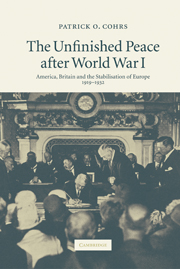Book contents
- Frontmatter
- Contents
- Acknowledgements
- List of abbreviations
- A note on the footnotes and bibliography
- Introduction
- Prologue
- 1 The wider challenges
- 2 Wilson, Lloyd George and the quest for a ‘peace to end all wars’
- 3 The ill-founded peace of 1919
- 4 The escalation of Europe's post-Versailles crisis, 1920–1923
- Part I The Anglo-American stabilisation of Europe, 1923–1924
- Part II Europe's nascent Pax Anglo-Americana, 1924–1925
- 11 The dawning of a Progressive Pax Americana in Europe?
- 12 Towards the Locarno pact
- 13 Regression?
- 14 Beyond irreconcilable differences?
- 15 The path to Locarno – and its transatlantic dimension
- 16 The second ‘real’ peace settlement after World War I
- Part III The unfinished transatlantic peace order: the system of London and Locarno, 1926–1929
- Epilogue
- Conclusion
- Map: Post-World War I Europe after the peace settlement of Versailles
- Bibliography
- Index
14 - Beyond irreconcilable differences?
New German and French approaches to European security
Published online by Cambridge University Press: 21 July 2009
- Frontmatter
- Contents
- Acknowledgements
- List of abbreviations
- A note on the footnotes and bibliography
- Introduction
- Prologue
- 1 The wider challenges
- 2 Wilson, Lloyd George and the quest for a ‘peace to end all wars’
- 3 The ill-founded peace of 1919
- 4 The escalation of Europe's post-Versailles crisis, 1920–1923
- Part I The Anglo-American stabilisation of Europe, 1923–1924
- Part II Europe's nascent Pax Anglo-Americana, 1924–1925
- 11 The dawning of a Progressive Pax Americana in Europe?
- 12 Towards the Locarno pact
- 13 Regression?
- 14 Beyond irreconcilable differences?
- 15 The path to Locarno – and its transatlantic dimension
- 16 The second ‘real’ peace settlement after World War I
- Part III The unfinished transatlantic peace order: the system of London and Locarno, 1926–1929
- Epilogue
- Conclusion
- Map: Post-World War I Europe after the peace settlement of Versailles
- Bibliography
- Index
Summary
How perceptive were British and American assessments of the Franco-German problem and the aims of French and German policymakers? Undoubtedly, Stresemann and Briand, who directed French foreign policy from April 1925, pursued different interests and agendas through the Rhine pact. Each had different ideas about what kind of security order and what wider consequences it was to engender. Apart from the British and the American, there were distinct French and German rationales for what became the Locarno system. Were these differences so fundamental that any pact could only conceal but not overcome them?
As will be shown, the status quo power France and the revisionist power Germany came to pursue different but not irreconcilable aims and strategies in the era of London and Locarno. There certainly was a tension between what Briand and Stresemann sought; but there was also a remarkable degree of common ground. A critical question became how far British diplomacy could propel a peace process that helped to maximise such common ground. And what part could US policy play under its self-imposed restraints? Re-appraising these questions requires, first, a further systematic comparison of French and German postwar policies, which centres on each power's approach to the Locarno pact.
Accommodation with the west and peaceful revision – Stresemann's Locarno policy
The unsettled security question and the need to counter what Berlin regarded as the danger of a reconstituted Anglo-French entente that again cemented the status quo and isolated Germany – these concerns lay behind the German Rhine pact initiative evolving, with D'Abernon's prodding, around the turn of 1924/5.
- Type
- Chapter
- Information
- The Unfinished Peace after World War IAmerica, Britain and the Stabilisation of Europe, 1919–1932, pp. 227 - 236Publisher: Cambridge University PressPrint publication year: 2006



